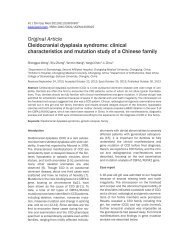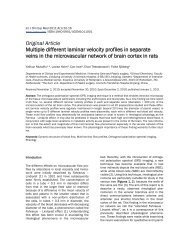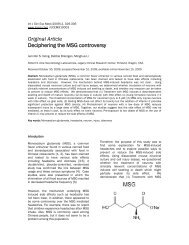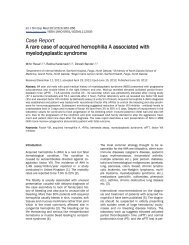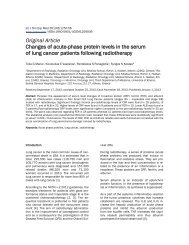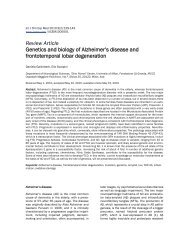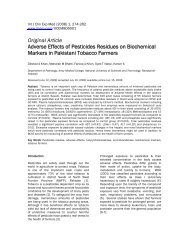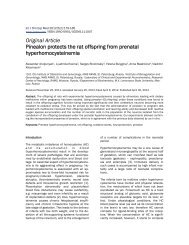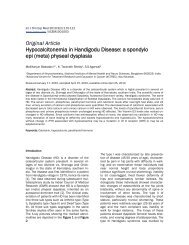Role of myeloid-specific G-protein coupled receptor kinase-2 in sepsis
Role of myeloid-specific G-protein coupled receptor kinase-2 in sepsis
Role of myeloid-specific G-protein coupled receptor kinase-2 in sepsis
Create successful ePaper yourself
Turn your PDF publications into a flip-book with our unique Google optimized e-Paper software.
Myeloid-<strong>specific</strong> G-<strong>prote<strong>in</strong></strong> <strong>coupled</strong> <strong>receptor</strong> <strong>k<strong>in</strong>ase</strong>-2 <strong>in</strong> <strong>sepsis</strong><br />
<strong>in</strong>crease <strong>in</strong> mortality may be related to the enhanced<br />
IL-6 observed <strong>in</strong> the GRK2 knockout<br />
mice early after <strong>sepsis</strong>. It is also possible that<br />
this may be due to difference <strong>in</strong> antibiotic resistance.<br />
Even though previous studies <strong>in</strong>clud<strong>in</strong>g<br />
ours predicted an important role for GRK2 <strong>in</strong><br />
<strong>sepsis</strong>, our results <strong>in</strong> this model <strong>of</strong> polymicrobial<br />
<strong>sepsis</strong> suggest that it may not be the case. It is<br />
also possible that while GRK2 may be critical,<br />
genetic deletion <strong>of</strong> GRK2 may result <strong>in</strong> compensation<br />
by other GRKs <strong>in</strong>clud<strong>in</strong>g GRK6, which<br />
has been shown before to regulate immune cell<br />
function [42]. In addition, it is possible that deletion<br />
<strong>of</strong> GRK2 <strong>in</strong> the <strong>myeloid</strong> compartment<br />
alone may not be sufficient to alter the phenotype<br />
<strong>in</strong> this model significantly. These ideas will<br />
be tested <strong>in</strong> future studies.<br />
In addition to regulation <strong>of</strong> TLR4, GRK2 has also<br />
been shown to play a key role <strong>in</strong> the phosphorylation<br />
and desensitization <strong>of</strong> chemok<strong>in</strong>e <strong>receptor</strong>s<br />
[37-40]. Based on this, <strong>in</strong>creased GRK2<br />
expression <strong>in</strong> neutrophils from human septic<br />
patients and septic mice has been associated<br />
with a decrease <strong>in</strong> chemotaxis <strong>in</strong> vitro [13, 20].<br />
Furthermore, TLRs have been shown to <strong>in</strong>crease<br />
expression <strong>of</strong> GRK2 <strong>in</strong> neutrophils and<br />
this also has been associated with downregulation<br />
<strong>of</strong> CXCR2 [20]. A recent study has proposed<br />
that TLR ligand <strong>in</strong>duced GRK2 expression can<br />
be negatively regulated by Interleuk<strong>in</strong>-33 [41].<br />
Thus, IL-33 could <strong>in</strong>directly then <strong>in</strong>crease the<br />
surface levels <strong>of</strong> CXCR2, thereby mediat<strong>in</strong>g enhanced<br />
neutrophil chemotaxis <strong>in</strong> <strong>sepsis</strong>, and<br />
this could result <strong>in</strong> a beneficial outcome. In the<br />
present study however, we did not observe any<br />
difference <strong>in</strong> chemotaxis to the primary site <strong>of</strong><br />
<strong>in</strong>fection even though GRK2 is deficient <strong>in</strong> both<br />
macrophages and neutrophils <strong>in</strong> the GRK2<br />
knockout mice. Consistent with the lack <strong>of</strong> enhanced<br />
neutrophil <strong>in</strong>filtration <strong>in</strong> our model, we<br />
did not observe any difference <strong>in</strong> the bacterial<br />
load <strong>in</strong> the peritoneum or <strong>in</strong> any other body<br />
compartments exam<strong>in</strong>ed. While an <strong>in</strong>crease <strong>in</strong><br />
neutrophil <strong>in</strong>filtration early after <strong>sepsis</strong> could<br />
enhance bacterial clearance and therefore protect<br />
mice from lethality [43], <strong>in</strong> our experiments<br />
lack <strong>of</strong> either enhanced chemotaxis or bacterial<br />
clearance was <strong>in</strong> fact associated with a modestly<br />
elevated lethality <strong>in</strong> the GRK2 knockout<br />
mice. Together, these results suggest that<br />
knockout <strong>of</strong> GRK2 <strong>in</strong> the <strong>myeloid</strong> compartment<br />
alone may not be sufficient to either prevent or<br />
enhance lethality <strong>in</strong> a significant way after polymicrobial<br />
<strong>sepsis</strong>.<br />
Even though GRK2 plays an important role <strong>in</strong><br />
GPCR-mediated signal<strong>in</strong>g and biology, recent<br />
studies have clearly demonstrated the importance<br />
<strong>of</strong> GRK2 <strong>in</strong> non-GPCR signal<strong>in</strong>g [6]. In<br />
particular, studies from our laboratory have<br />
shown that GRK2 can negatively regulate TLR4-<br />
<strong>in</strong>duced signal<strong>in</strong>g and cytok<strong>in</strong>e/chemok<strong>in</strong>e<br />
(<strong>in</strong>clud<strong>in</strong>g IL-6 and IL-10) production <strong>in</strong> peritoneal<br />
macrophages [9]. The question still rema<strong>in</strong>s<br />
whether the early-enhanced pro<strong>in</strong>flammatory<br />
phase (systemic IL-6 and IL-6:IL-<br />
10 ratio) observed <strong>in</strong> this model <strong>of</strong> <strong>sepsis</strong> is<br />
because <strong>of</strong> GRK2’s role <strong>in</strong> GPCR or non-GPCR<br />
(such as TLR4) signal<strong>in</strong>g. One <strong>of</strong> the primary<br />
classes <strong>of</strong> GPCRs that GRK2 regulates <strong>in</strong> the<br />
immune system is the chemok<strong>in</strong>e <strong>receptor</strong>. If<br />
the observed phenotype <strong>in</strong> the GRK2 knockout<br />
is due to altered signal<strong>in</strong>g <strong>of</strong> the chemok<strong>in</strong>e<br />
<strong>receptor</strong>s, one would expect differences <strong>in</strong> migration<br />
<strong>of</strong> the immune cells at least to the peritoneum<br />
(the <strong>in</strong>itial site <strong>of</strong> <strong>in</strong>fection). S<strong>in</strong>ce that<br />
was not the case, it would argue aga<strong>in</strong>st a role<br />
for excessive chemok<strong>in</strong>e <strong>receptor</strong> signal<strong>in</strong>g.<br />
Other GPCRs such as C3aR and C5aR<br />
(<strong>receptor</strong>s for complements C3a and C5a) have<br />
also been shown to play a crucial role <strong>in</strong> the<br />
pathogenesis <strong>of</strong> <strong>sepsis</strong> [31]. C5aR especially<br />
has been shown to be an important regulator <strong>of</strong><br />
IL-6 production <strong>in</strong> vivo <strong>in</strong> the CLP model <strong>of</strong> <strong>sepsis</strong><br />
[44, 45]. Even though <strong>in</strong> vitro studies have<br />
shown an important role for GRK2 <strong>in</strong> the regulation<br />
<strong>of</strong> complement <strong>receptor</strong>s [46-48], the <strong>in</strong><br />
vivo role <strong>of</strong> GRK2 <strong>in</strong> C5aR signal<strong>in</strong>g especially <strong>in</strong><br />
the context <strong>of</strong> <strong>sepsis</strong> is unknown and will be the<br />
subject <strong>of</strong> future studies.<br />
Although other studies prior to ours have implicated<br />
a role for GRK2 <strong>in</strong> the pathogenesis <strong>of</strong><br />
<strong>sepsis</strong> [13, 41], this is the first study to directly<br />
exam<strong>in</strong>e the role <strong>of</strong> <strong>myeloid</strong>-<strong>specific</strong> GRK2 <strong>in</strong> a<br />
cl<strong>in</strong>ically relevant model <strong>of</strong> polymicrobial <strong>sepsis</strong>.<br />
Our results demonstrate that knockout <strong>of</strong> GRK2<br />
<strong>in</strong> macrophages and neutrophils may not be<br />
sufficient to modulate the outcome <strong>of</strong> <strong>sepsis</strong>.<br />
Future studies will determ<strong>in</strong>e if whole body<br />
knockout <strong>of</strong> GRK2 or knockout <strong>of</strong> GRK2 <strong>in</strong> tissue<br />
compartments other than <strong>myeloid</strong> cells<br />
might be important <strong>in</strong> the pathogenesis <strong>of</strong> <strong>sepsis</strong>.<br />
Acknowledgments<br />
We gratefully acknowledge the support from NIH<br />
(grants HL095637, AR055726 and AR056680<br />
to N.P.). We thank the university lab animal re-<br />
327 Int J Cl<strong>in</strong> Exp Med 2011;4(4):320-330



